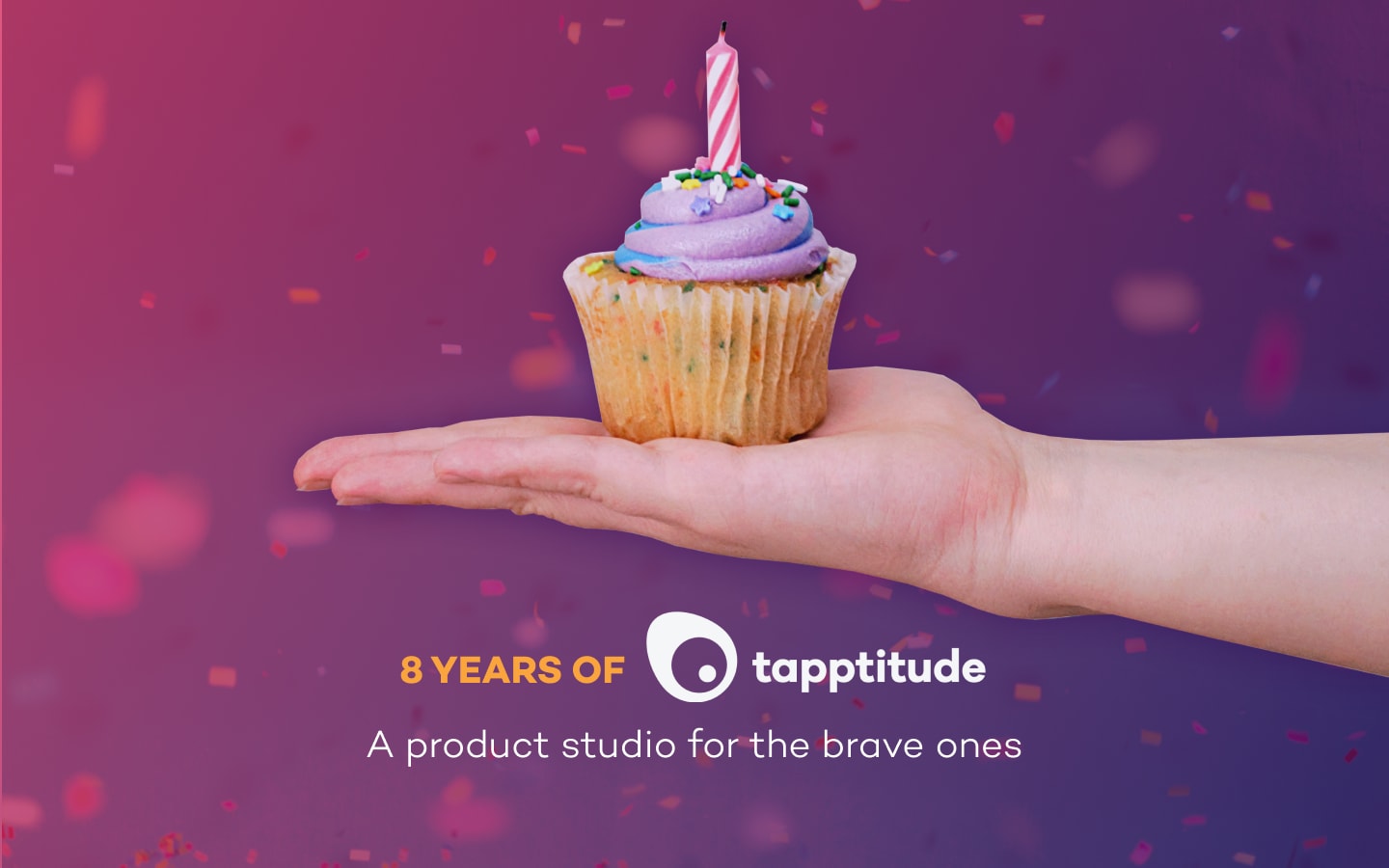It’s our birthday! If it’s November, it means Tapptitude turns 8 and that’s a pretty big reason for celebration. We’ve made it through another 365 days of calls, coding, wireframing and prototyping, bug fixing and good old-fashioned writing—all for the straightforward goal of building great products that people love to use.
We wanted to step back and share with you some of the things we’ve learned in the last year (and even prior to that), as we’ve fully embraced being a product studio for the long run with our special partners.
The founders we collaborate with start thinking of their product concept a year, six months before actually starting to work on it. And when they do, they bravely commit their time, and their knowledge, and their budget to their startup. Not just the first day when they google their idea. Or the second day when they start asking about resources. Or a month or two later, when they decide who they’ll work with.
They commit every day to making the best decisions possible to build the best version of their product and bring a positive effect into the lives of the people they’re working for. That’s what makes them brave, and what makes us privileged to work with them.
We’ve been working with founders committed to building great products for the last 8 years, and we wanted to share the key takeaways we’re bringing with us into working with founders for the next year.
1. It’s more likely than you think to want a product partner.
Founders come to us thanks to what they find on our website and in our reviews. The tech stack, the projects, the vibe of “they seem to know what they’re doing” are all pretty convincing, if you don’t mind us saying that. But what really lights them up is having a conversation where we ask them about:
- Pre- and post-product launch validation
- How are they looking to scale their product
- What kind of relationship are they looking to have with their agency?
When we tell them we’re willing to take on their success as an internal team would, share our expertise and help them make decisions instead of waiting for everything to be handed to us, that’s the moment most founders have their ‘aha’ moment with us. Because working on their product is an exciting, rewarding experience. But realizing it’s something they don’t have to do alone as they struggle to make it through another round of sprints, marketing, and fundraising is even better.
2. Great products solve a problem that matters for a big enough number of people.
People build products because they want to own their time and their careers. Because they care about something strongly enough they want to fix it. Because there are enough success stories out there to have them believe that it’s possible to make it.
The really good founders we’ve worked with have that, plus more as they set out. They know that for every success story, there are about nine stories about failure, and they probably have a failure story of their own. They also know that great products don’t stop building themselves after they get launched. What they need, in fact, is momentum. That’s why they’ll focus on a problem that affects a large enough number of people. The bigger the scale of the problem, the easier it becomes to address the specific audience that will care about a new solution that will fix that problem. And more importantly, it becomes a little easier to raise funds to keep the product on a growth path.
3. De-risking is a process, not a one-time decision.
As we start our collaboration with a founder, we talk a lot about doing early validation, and planning an MVP that proves it can deliver value to the core audience of their product, with the least investment, in the context of what other alternatives they have at hand.
But the fact of the matter is that a product doesn’t exist in a vacuum. People use it, and the way they use it may be unexpected for them, and even their competitors may change their features in time. Your role as the founder is to take in the feedback you’re getting and plan the next iterations of your product. And to keep doing this with the least risks associated, while making the next best decision for users and the audience you’re trying to reach.
4. A good product partner will help you look at your problems from different perspectives.
A founder’s goal isn’t to just build a product. It’s to build a product that has reached product-market fit and scale. And this is where a product partner like Tapptitude is such a valuable asset. We not only bring our technical expertise to the table, but also the experience of seeing over 100 products being launched. Some of them scaled successfully, some stayed small, but persistently appreciated apps, and some ran out of money before they could reach any kind of goals.
When we work with a new founder on their product, we’re often there for them when they struggle with what feature to build next, what audience to focus on, how to measure if what they’re doing is right. Often, the answer lies in putting together a product mindset with a good knowledge of the product’s industry and looking at it from the right perspective. Often, getting the answer right lies in talking your options out with someone who knows your end goals, who’s been building the product with you, and has different, but just as valuable, skills from you.
5. You have to define success to be able to measure it.
We’ve mentioned before how building a product is an iterative process of validating what works for your audience and adding features that will bring more value both to them and to your business. What we haven’t covered yet is how do you know if what you’re doing is right?
There’s the big-picture way of looking at this, which is to try and define your product’s North Star Metric and map out all the input metrics that have an impact on it. Then, you monitor those.
The more focused way of working on this is to identify what is the positive outcome you expect from your new iteration and find metrics to measure for that. Say you introduce streaks into your fitness app because you want people to build long-term workout habits. Sounds great as an outcome, but how do you measure it? Well, you can count the number of returning users, the length of a streak, the duration of a workout session, the difficulty of a workout session compared to the time the app’s been used.
Our job as your product-building studio is to help you look beyond the next product decision and develop a way to measure its impact. Part of it is setting up an analytics infrastructure, and part of it is deciding what metrics are relevant in each use case.
6. Ask, don’t assume. It’ll save a lot of headaches.
There are a lot of benefits to working in an internationally-based product studio. On one side, you’ve got the Tapp Squad bringing in all their expertise in strategy, design, development and quality assurance. On the other side, we get to work with founders from all over the world. What gets talked about less is how the tech and startup industry has a habit of borrowing words from other industries or applying things differently depending on when and where they’ve learned them from.
It becomes that much more important to approach each conversation with a learning mindset and be aware of when you’re making assumptions instead of asking questions. Asking upfront creates less confusion and builds stronger collaborations, and most importantly, helps us navigate the specifics of a new audience or industry as we immerse ourselves in it.
7. Running a startup is an emotional rollercoaster, but we’re here to help.
Building a product, like most things in life, is expecting you to have it all figured out only to discover that you’ve got nothing figured out. More experienced founders will tell you that every meme and anecdote about the emotional rollercoaster of running a startup is true. So you’ll need some level of distress tolerance and a healthy way to calculate what kind of risks you’re willing to take, both with your audience and with your money.
And when you don’t have your own baseline of what is normal for running a startup, relying on an experienced product partner is the next best thing.
8. Despite the unexpected, everything can get sorted.
Despite the occasional weird user feedback, the unexpected app store rejections, the bugs that are hard to fix, the data dashboards that sometimes look like something out of Alice-in-wonderland, the hard conversations before hard decisions get made, the fact of the matter is that we love mobile products, and we love building them with people who are as passionate about them as we are. When the unexpected shows up, we know that there’s a way to get it sorted. The end goal, after all, is always the same: build a product people love to use.

_
There’s a lot we’ve learned in the last year by working as a product-building studio. We’ve seen the commitment of founders to build products that bring value in the long run. Founders who want to learn how to build products the right way do this:
- By managing their resources right
- By managing their risks right
- By monitoring their progress right
- By building their relationships right
It’s been easy to become partners in their journey from concept to scale-up, because the things they’ve been committed to are the things we care about in the work we do every day. And it’s the work we hope we’ll keep doing from now on as well.

Erika Kramarik
Full-Stack Marketer
Erika is a full-stack marketer passionate about the intersection between technology and social impact. She mixes research with content design and a human touch to help people and startups succeed in delivering value through their work. When not writing or talking to people, you’ll find her reading or quoting Hamilton for any life situation.





